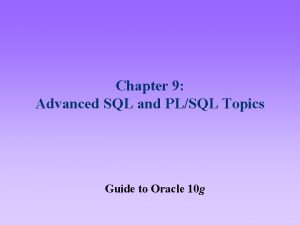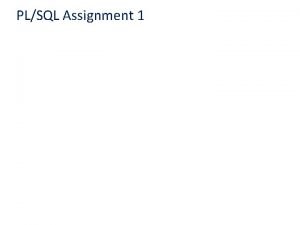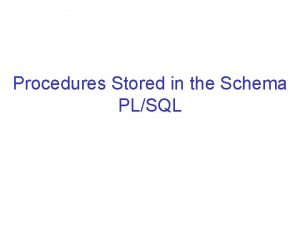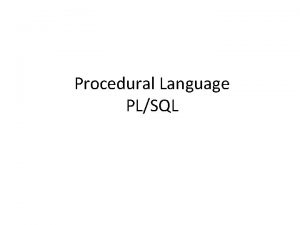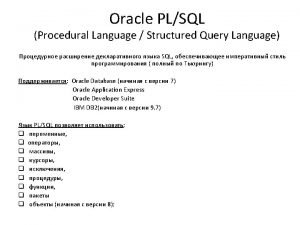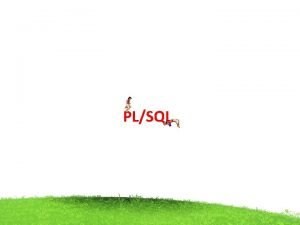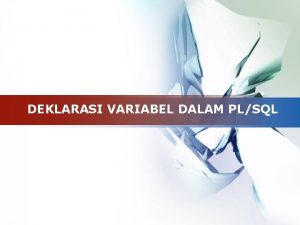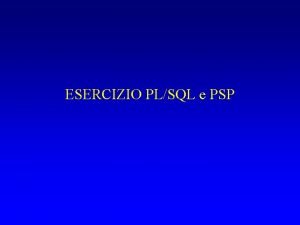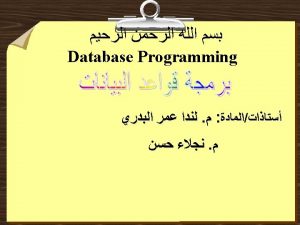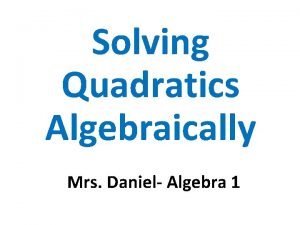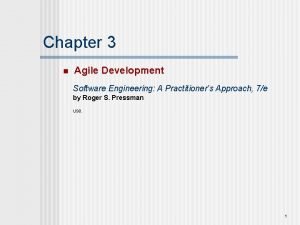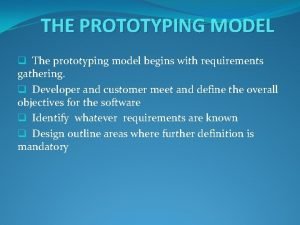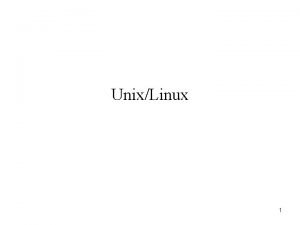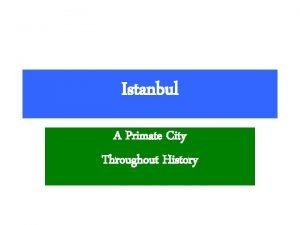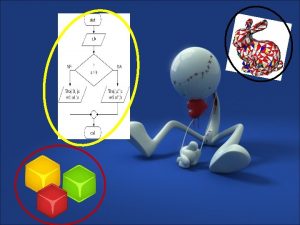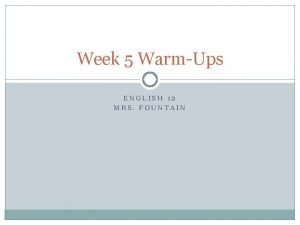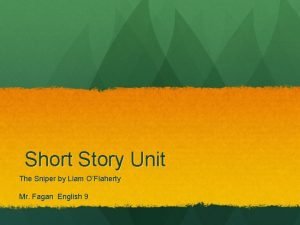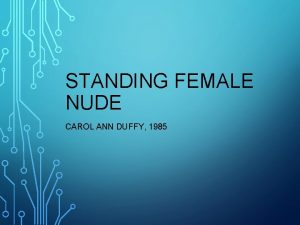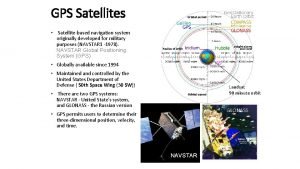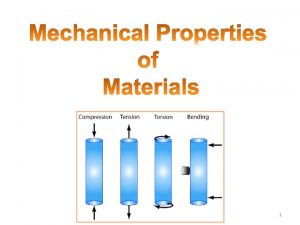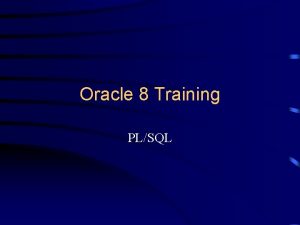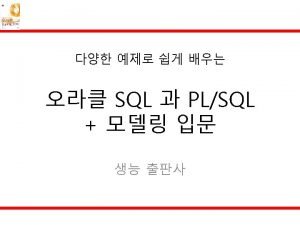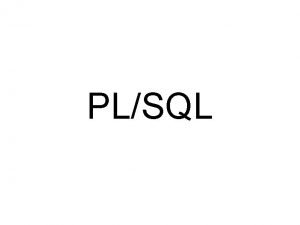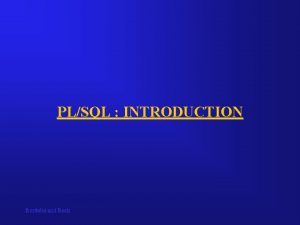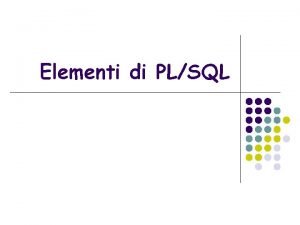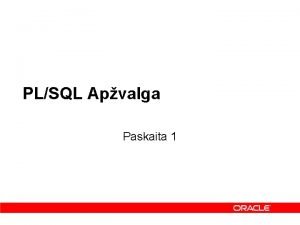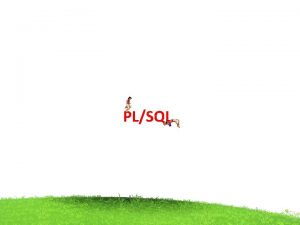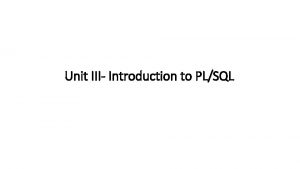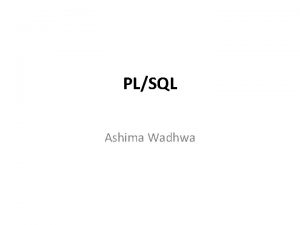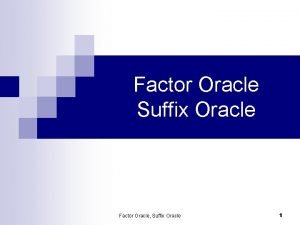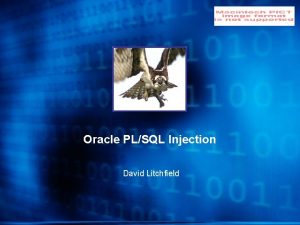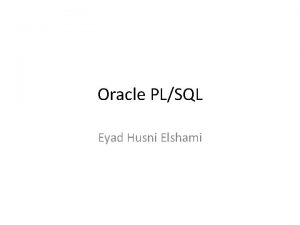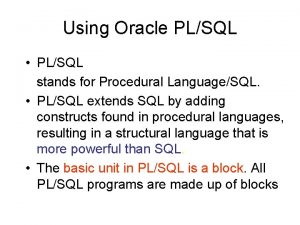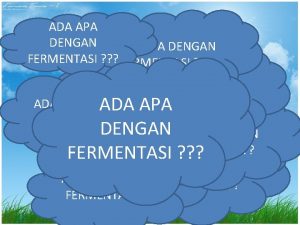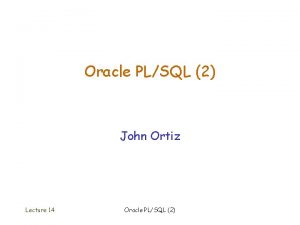Oracle PLSQL PLSQL n Originally modeled after ADA












































- Slides: 44

Oracle PL/SQL

PL/SQL n Originally modeled after ADA • Created for Dept. of Defense n n Allows expanded functionality of database applications Continues to improve with each new database release

PL/SQL n Features • Tight integration with SQL n Supports data types, functions, pseudo-columns, etc. • Increased performance n A block of statements sent as a single statement • Increased productivity n Same techniques can be used with most Oracle products • Portability n Works on any Oracle platform • Tighter security n Users may access database objects without granted privileges

PL/SQL Programs n Declaration section (optional) • Any needed variables declared here n Executable or begin section • Program code such as statements to retrieve or manipulate data in a table n Exception section (optional) • Error traps can catch situations which might ordinarily crash the program

PL/SQL Block Structure

PL/SQL Variables n n n Variables are local to the code block Names can be up to 30 characters long and must begin with a character Declaration is like that in a table • Name then data type the semi-colon • Can be initialized using : = operator in the declaration • Can be changed with : = in the begin section • Can use constraints n Variables can be composite or collection types • Multiple values of different or same type

Common PL/SQL Data Types • • CHAR ( max_length ) VARCHAR 2 ( max_length ) NUMBER ( precision, scale ) BINARY_INTEGER – more efficient than number RAW ( max_length ) DATE BOOLEAN (true, false, null) Also LONG, LONG RAW and LOB types but the capacity is usually less in PL/SQL than SQL

PL/SQL Variable Constraints n NOT NULL • Can not be empty n CONSTANT • Can not be changed

PL/SQL Variables Examples Age number; Last char ( 10 ); DVal Date : = Sysdate; SID number not null; Adjust constant number : = 1; Can. Loop boolean : = true

Predefined Exceptions n INVALID_NUMBER (ORA-01722) • Attempted to store non-numeric data in a variable with a numeric data type n NO_DATA_FOUND (ORA-01403) • Query resulted in no rows being found n NOT_LOGGED_ON (ORA-01012) • Not currently connected to an Oracle database n TOO_MANY_ROWS (ORA-01422) • A SELECT INTO statement returned more than one row

Predefined Exceptions (cont. ) n DUP_VALUE_ON_INDEX (ORA-00001) • Value inserted for a primary key is not unique n VALUE_ERROR (ORA-06502) • The value being placed in a variable is the wrong length or data type n ZERO_DIVIDE (ORA-01476) • An attempt was made to divide a number by zero

Structure of Exception Section

Conditional Structures n IF-THEN-ELSE n IF-THEN-ELSIF • An alternative to nested IF-THEN_ELSE

IF-THEN Structure

IF-THEN-ELSE Structure

IF-THEN-ELSIF Structure

Stored Procedures

Stored Procedures n n The first line is called the Procedure Specification The remainder is the Procedure Body A procedure is compiled and loaded in the database as an object Procedures can have parameters passed to them

Stored Procedures n n Run a procedure with the PL/SQL EXECUTE command Parameters are enclosed in parentheses

Stored Functions n Like a procedure except they return a single value

Triggers n n Associated with a particular table Automatically executed when a particular event occurs • Insert • Update • Delete • Others

Triggers vs. Procedures n n n Procedures are explicitly executed by a user or application Triggers are implicitly executed (fired) when the triggering event occurs Triggers should not be used as a lazy way to invoke a procedure as they are fired every time the event occurs

Triggers

Triggers n n The trigger specification names the trigger and indicates when it will fire The trigger body contains the PL/SQL code to accomplish whatever task(s) need to be performed

Triggers

Triggers Timing n A triggers timing has to be specified first • Before (most common) n Trigger should be fired before the operation • i. e. before an insert • After n Trigger should be fired after the operation • i. e. after a delete is performed

Trigger Events n Three types of events are available • DML events • DDL events • Database events

DML Events n Changes to data in a table • Insert • Update • Delete

DDL Events n Changes to the definition of objects • Tables • Indexes • Procedures • Functions • Others n Include CREATE, ALTER and DROP statements on these objects

Database Events n n n Server Errors Users Log On or Off Database Started or Stopped

Trigger DML Events n Can specify one or more events in the specification • i. e. INSERT OR UPDATE OR DELETE n Can specify one or more columns to be associated with a type of event • i. e. BEFORE UPDATE OF SID OR SNAME

Table Name n The next item in the trigger is the name of the table to be affected

Trigger Level n Two levels for Triggers • Row-level trigger n Requires FOR EACH ROW clause • If operation affects multiple rows, trigger fires once for each row affected • Statement-level trigger • DML triggers should be row-level • DDL and Database triggers should not be row-level

Event Examples

Triggers n Conditions Available So Multiple Operations Can Be Dealt With In Same Trigger • Inserting, Updating, Deleting n Column Prefixes Allow Identification Of Value Changes • New, Old

Triggers Exceptions n n n EXCEPTION Data Type Allows Custom Exceptions RAISE Allows An Exception To Be Manually Occur RAISE_APPLICATION_ERROR Allows Termination Using A Custom Error Message • Must Be Between -20000 and -20999 • Message Can Be Up to 512 Bytes

Cursors n n Cursors Hold Result of an SQL Statement Two Types of Cursors in PL/SQL • Implicit – Automatically Created When a Query or Manipulation is for a Single Row • Explicit – Must Be Declared by the User n Creates a Unit of Storage Called a Result Set

Cursors Result Set MIS 380 MIS 202 MIS 485 MIS 480 DATABASE DESIGN INFORMATION SYSTEMS MANAGING TECHNOLOGY ADVANCED DATABASE 4 3 <Cursor 4 4

Cursors n Declaring an Explicit Cursor CURSOR Cursor. Name IS Select. Statement; n Opening an Explicit Cursor OPEN Cursor. Name; n Accessing Rows from an Explicit Cursor FETCH Cursor. Name INTO Row. Variables;

Cursors n Declaring Variables of the Proper Type with %TYPE Var. Name Table. Name. Field. Name%TYPE; n Declaring Variables to Hold An Entire Row Var. Name Cursor. Name%ROWTYPE; n Releasing the Storage Area Used by an Explicit Cursor CLOSE Cursor. Name;

Iterative Structures n LOOP … EXIT … END LOOP • EXIT with an If Avoids Infinite Loop n LOOP … EXIT WHEN … END LOOP • Do Not Need An If to Control EXIT n WHILE … LOOP … END LOOP • Eliminates Need for EXIT n FOR … IN … END LOOP • Eliminates Need for Initialization of Counter

Cursor Control With Loops n n Need a Way to Fetch Repetitively Need a Way to Determine How Many Rows to Process With a Cursor • Cursor Attributes Cursor. Name%ROWCOUNT – Number of Rows in a Result Set n Cursor. Name%FOUND – True if a Fetch Returns a Row n Cursor. Name%NOTFOUND – True if Fetch Goes Past Last Row n

Cursor For Loop n n Processing an Entire Result Set Common Special Form of FOR … IN to Manage Cursors No Need for Separate OPEN, FETCH and CLOSE statements Requires %ROWTYPE Variable

 After me after me after me
After me after me after me John 14:1-3
John 14:1-3 Nilai dari tabel kebenaran biimplikasi adalah
Nilai dari tabel kebenaran biimplikasi adalah Gaya terdiri dari tarikan
Gaya terdiri dari tarikan Dalam laporan percobaan tidak ada urutan waktu tetapi ada
Dalam laporan percobaan tidak ada urutan waktu tetapi ada Cursores plsql
Cursores plsql Plsql topics
Plsql topics Pl/sql assignment
Pl/sql assignment Stored procedure plsql
Stored procedure plsql Plsql is
Plsql is Difference between sql and plsql
Difference between sql and plsql Record type in plsql
Record type in plsql Cursors are memory areas
Cursors are memory areas Binding variables in oracle
Binding variables in oracle Create table in procedure oracle
Create table in procedure oracle Plsql programming
Plsql programming The path of a placekicked football can be modeled
The path of a placekicked football can be modeled Which sum or difference is modeled by the algebra tiles
Which sum or difference is modeled by the algebra tiles The biography of langston hughes
The biography of langston hughes Elizabethan tragedies were modeled on plays from
Elizabethan tragedies were modeled on plays from Daniel kicks a soccer ball and the trajectory is modeled by
Daniel kicks a soccer ball and the trajectory is modeled by Geometry lesson 1-1 answers
Geometry lesson 1-1 answers The most widely used agile process, originally proposed by
The most widely used agile process, originally proposed by Originally by carol ann duffy analysis
Originally by carol ann duffy analysis The spiral model was originally proposed by
The spiral model was originally proposed by Where do bananas originally come from
Where do bananas originally come from Unix was originally developed in
Unix was originally developed in What organism was aspirin originally extracted from
What organism was aspirin originally extracted from How was the coffee maker originally made
How was the coffee maker originally made Who invented play doh
Who invented play doh Whats a primate city
Whats a primate city Tentaizu backtracking
Tentaizu backtracking Even though beowulf was originally dgp
Even though beowulf was originally dgp Which letter indicates when dinosaurs became extinct?
Which letter indicates when dinosaurs became extinct? The sniper is written by
The sniper is written by Manmeet gill
Manmeet gill Mrs midas genius
Mrs midas genius Originally carol ann duffy questions
Originally carol ann duffy questions Skelf of shame
Skelf of shame Why was the gps network originally developed
Why was the gps network originally developed Originally carol ann duffy annotated
Originally carol ann duffy annotated Where did the vikings raid
Where did the vikings raid A piece of copper originally 305mm long
A piece of copper originally 305mm long A biologist originally marked 40 butterflies
A biologist originally marked 40 butterflies History of volleyball
History of volleyball






